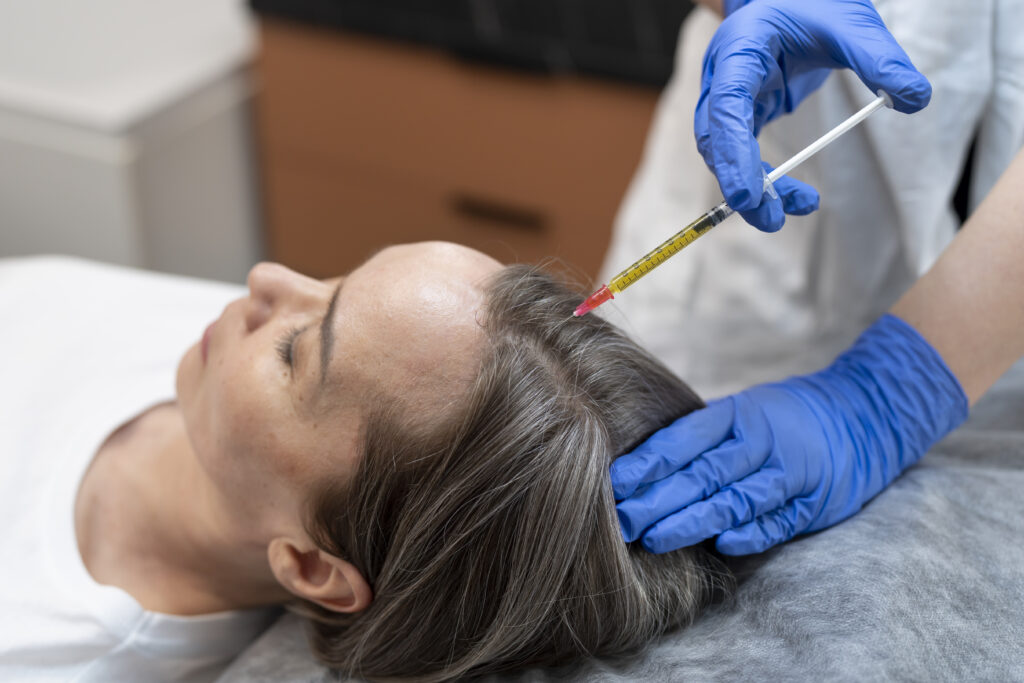Hair loss and scalp disorders are common concerns that affect millions of people worldwide. Dermatologists specialize in diagnosing and treating hair and scalp conditions, offering medical, surgical, and cosmetic solutions. In this blog, we’ll explore common hair problems, their causes, and the latest treatments available in dermatology.
Common Hair and Scalp Conditions
1. Androgenetic Alopecia (Male & Female Pattern Baldness)
- Cause: Genetic predisposition and hormonal factors (DHT sensitivity).
- Symptoms: Gradual thinning in men (receding hairline, crown balding) and diffuse thinning in women.
- Treatment:
- Topical Minoxidil (Rogaine) – Stimulates hair growth.
- Oral Finasteride (Propecia) – Blocks DHT (for men only).
- Low-Level Laser Therapy (LLLT) – Enhances follicle activity.
- Platelet-Rich Plasma (PRP) Therapy – Uses growth factors to stimulate hair growth.
- Hair Transplant Surgery – Follicular Unit Extraction (FUE) or Strip Method (FUT).
2. Alopecia Areata (Autoimmune Hair Loss)
- Cause: Immune system attacks hair follicles.
- Symptoms: Patchy hair loss on scalp, beard, or body.
- Treatment:
- Corticosteroid Injections – Reduces inflammation.
- Topical Immunotherapy (Diphencyprone/DPCP).
- Oral JAK Inhibitors (e.g., Tofacitinib, Ritlecitinib) – Emerging treatment.
- Microneedling with PRP – Boosts regrowth.
3. Telogen Effluvium (Temporary Hair Shedding)
- Cause: Stress, illness, surgery, childbirth, or nutritional deficiencies.
- Symptoms: Sudden, diffuse hair shedding.
- Treatment:
- Identify & Address Trigger (e.g., iron deficiency, thyroid issues).
- Nutritional Supplements (Biotin, Iron, Zinc, Vitamin D).
- Topical Growth Stimulants (Minoxidil).
4. Seborrheic Dermatitis & Dandruff
- Cause: Fungal overgrowth (Malassezia), oiliness, or inflammation.
- Symptoms: Flaky scalp, redness, itching.
- Treatment:
- Medicated Shampoos (Ketoconazole, Selenium Sulfide, Zinc Pyrithione).
- Topical Steroids (For severe inflammation).
- Antifungal Creams (Clotrimazole).
5. Scarring Alopecia (Cicatricial Alopecia)
- Cause: Inflammation destroys hair follicles permanently (e.g., Lichen Planopilaris, Lupus).
- Symptoms: Patchy hair loss with scarring.
- Treatment:
- Early Anti-inflammatory Therapy (Steroids, Hydroxychloroquine).
- Hair Transplant (Only if condition is stable).
Advanced Hair Treatments in Dermatology
1. Platelet-Rich Plasma (PRP) Therapy
- How it works: Blood is drawn, processed to concentrate platelets, and injected into the scalp to stimulate hair growth.
- Best for: Androgenetic alopecia, alopecia areata.
2. Low-Level Laser Therapy (LLLT)
- How it works: Lasers increase blood flow and cellular activity in follicles.
- Devices: FDA-cleared laser combs/caps (e.g., Theradome, Capillus).
3. Hair Transplant Surgery
- FUE (Follicular Unit Extraction): Individual follicles are extracted and transplanted.
- FUT (Follicular Unit Transplantation): A strip of scalp is removed, dissected, and transplanted.
4. Oral & Topical Anti-Androgens (For Women)
- Spironolactone – Blocks androgens in female pattern hair loss.
- Topical Finasteride – Lower systemic side effects.
Preventive Hair Care Tips
✔ Balanced Diet – Protein, iron, omega-3s, vitamins.
✔ Gentle Hair Care – Avoid tight hairstyles, excessive heat.
✔ Stress Management – Yoga, meditation to reduce telogen effluvium.
✔ Regular Check-ups – Rule out thyroid, hormonal, or autoimmune issues.
Final Thoughts
Hair loss can be distressing, but modern dermatology offers effective solutions. Early diagnosis and personalized treatment plans can significantly improve hair health. If you’re experiencing hair thinning or scalp issues, consult a board-certified dermatologist for the best approach.

Leave a Reply